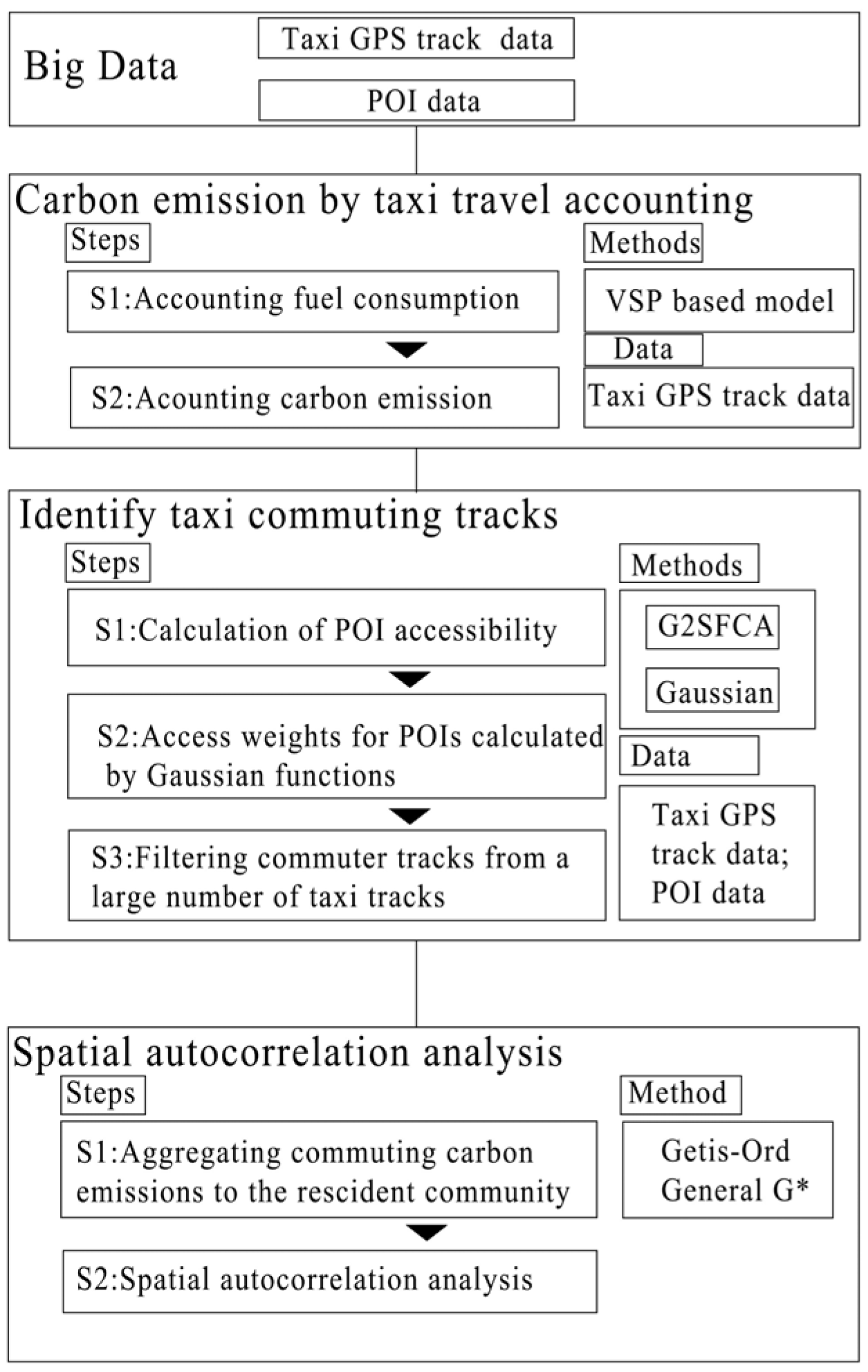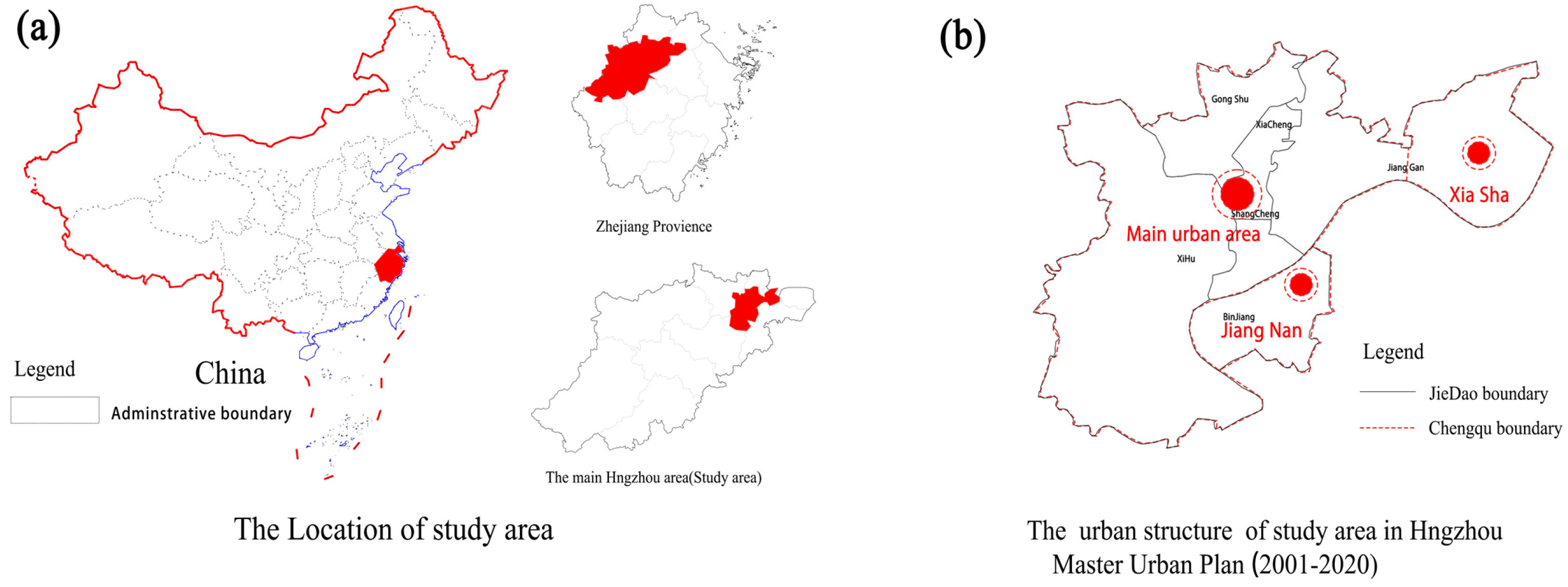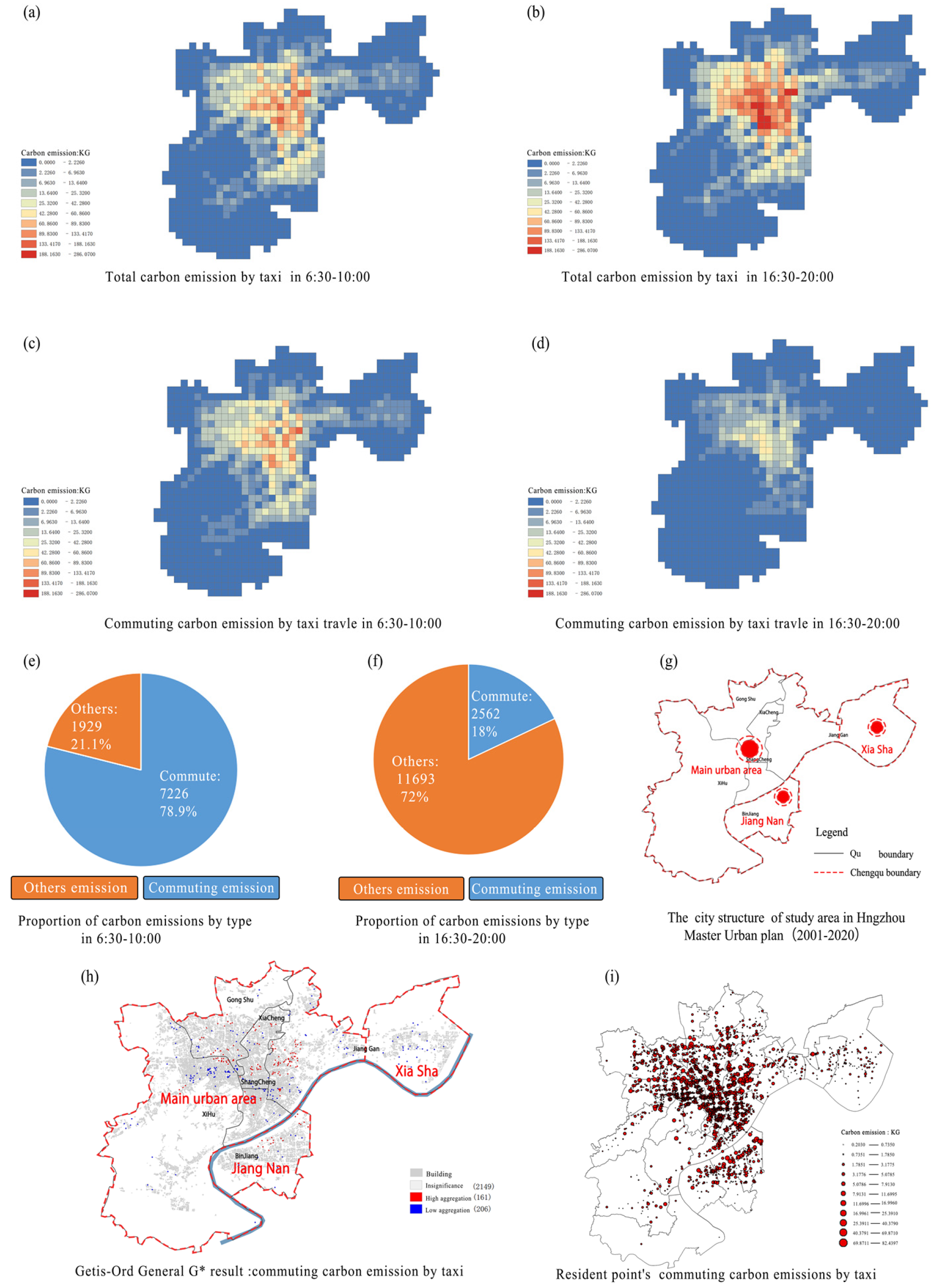A Big Data-Based Commuting Carbon Emissions Accounting Method—A Case of Hangzhou
Abstract
:1. Introduction
2. Materials and Methods
2.1. Framework
2.2. Study Area
2.3. Data Collection
2.3.1. Taxi GPS Data
2.3.2. POI Data
2.4. Method
2.4.1. Taxi Carbon Emission Modelling
2.4.2. Identification of Travel Origins and Destinations
2.4.3. Spatial Autocorrelation Analysis of Carbon Emissions from Residential Communities
3. Results
3.1. Accounting for Residential Commuting Carbon Emissions of Taxis
3.1.1. Carbon Emissions of Taxi Travel
3.1.2. Estimated Types of Residential Trips
3.1.3. Estimated Residential Commuting Carbon Emissions of Taxi Travel
3.2. Spatial Autocorrelation Analysis of Carbon Emissions from Residential Point Taxi Commuting
4. Discussion
4.1. Discussion of the Results of the Proposed Carbon Emissions Accounting for Taxi Trips Based on the VSP Model
4.1.1. Comparison of Traditional Carbon Emission and VSP Model-Based Carbon Emission Estimations
4.1.2. Comparison of Taxi and Traditional Commuting Investigations
4.2. The Impact of Urban Spatial Structure and the Construction of Urban Public Transport Facilities on Carbon Emissions by Taxis
5. Conclusions
Author Contributions
Funding
Institutional Review Board Statement
Informed Consent Statement
Data Availability Statement
Conflicts of Interest
References
- Pawłowski, L.; Litwińczuk, Z.; Zhou, G. (Eds.) The Role of Agriculture in Climate Change Mitigation, 1st ed.; CRC Press: Boca Raton, FL, USA, 2020; ISBN 978-1-00-300273-4. [Google Scholar]
- Dong, Z.; Xia, C.; Fang, K.; Zhang, W. Effect of the Carbon Emissions Trading Policy on the Co-Benefits of Carbon Emissions Reduction and Air Pollution Control. Energy Policy 2022, 165, 112998. [Google Scholar] [CrossRef]
- Wang, X.; Chen, S. Urban-Rural Carbon Footprint Disparity across China from Essential Household Expenditure: Survey-Based Analysis, 2010–2014. J. Environ. Manag. 2020, 267, 110570. [Google Scholar] [CrossRef] [PubMed]
- Liu, Z.; Deng, Z.; Davis, S.J.; Giron, C.; Ciais, P. Monitoring Global Carbon Emissions in 2021. Nat. Rev. Earth Environ. 2022, 3, 217–219. [Google Scholar] [CrossRef] [PubMed]
- He, Y.; Xia, C.; Shao, Z.; Zhao, J. The Spatiotemporal Evolution and Prediction of Carbon Storage: A Case Study of Urban Agglomeration in China’s Beijing-Tianjin-Hebei Region. Land 2022, 11, 858. [Google Scholar] [CrossRef]
- Li, S.; Zhao, P. Examining Commuting Disparities across Different Types of New Towns and Different Income Groups: Evidence from Beijing, China. Habitat Int. 2022, 124, 102558. [Google Scholar] [CrossRef]
- Li, T.; Wu, J.; Dang, A.; Liao, L.; Xu, M. Emission Pattern Mining Based on Taxi Trajectory Data in Beijing. J. Clean. Prod. 2019, 206, 688–700. [Google Scholar] [CrossRef]
- Luo, X.; Dong, L.; Dou, Y.; Zhang, N.; Ren, J.; Li, Y.; Sun, L.; Yao, S. Analysis on Spatial-Temporal Features of Taxis’ Emissions from Big Data Informed Travel Patterns: A Case of Shanghai, China. J. Clean. Prod. 2017, 142, 926–935. [Google Scholar] [CrossRef]
- Xia, C.; Li, Y.; Xu, T.; Chen, Q.; Ye, Y.; Shi, Z.; Liu, J.; Ding, Q.; Li, X. Analyzing Spatial Patterns of Urban Carbon Metabolism and Its Response to T Change of Urban Size: A Case of the Yangtze River Delta, China. Ecol. Indic. 2019, 11, 184–200. [Google Scholar] [CrossRef]
- Xia, C.; Li, Y.; Ye, Y.; Shi, Z.; Liu, J. Decomposed Driving Factors of Carbon Emissions and Scenario Analyses of Low-Carbon Transformation in 2020 and 2030 for Zhejiang Province. Energies 2017, 10, 1747. [Google Scholar] [CrossRef] [Green Version]
- Fang, K.; Li, C.; Tang, Y.; He, J.; Song, J. China’s Pathways to Peak Carbon Emissions: New Insights from Various Industrial Sectors. Appl. Energy 2022, 306, 118039. [Google Scholar] [CrossRef]
- Fang, K.; Zhang, Q.; Song, J.; Yu, C.; Zhang, H.; Liu, H. How Can National ETS Affect Carbon Emissions and Abatement Costs? Evidence from the Dual Goals Proposed by China’s NDCs. Resour. Conserv. Recycl. 2021, 171, 105638. [Google Scholar] [CrossRef]
- Song, J.; Qi, Z.; Gai, Y.; Chen, S. Shared Network and Supply Chain Features for Synergetic Control of Carbon and Air Pollutant Emissions. Sci. Total Environ. 2022, 827, 154391. [Google Scholar] [CrossRef]
- Liu, Z.; Sun, T.; Yu, Y.; Ke, P.; Deng, Z.; Lu, C.; Huo, D.; Ding, X. Real-Time Carbon Emission Accounting Technology toward Carbon Neutrality. Engineering 2022, S2095809922001400. [Google Scholar] [CrossRef]
- Cai, H.; Xie, S. Estimation of Vehicular Emission Inventories in China from 1980 to 2005. Atmos. Environ. 2007, 41, 8963–8979. [Google Scholar] [CrossRef]
- Wang, H.; Chen, C.; Huang, C.; Fu, L. On-Road Vehicle Emission Inventory and Its Uncertainty Analysis for Shanghai, China. Sci. Total Environ. 2008, 398, 60–67. [Google Scholar] [CrossRef]
- Lyu, T.; Wang, P.; Gao, Y.; Wang, Y. Research on the Big Data of Traditional Taxi and Online Car-Hailing: A Systematic Review. J. Traffic Transp. Eng. (Engl. Ed.) 2021, 8, 1–34. [Google Scholar] [CrossRef]
- Zhenbo, W.; Jingtong, Z.; Shunfeng, S. Study on the Commuting Characteristics of Urban Residents and Its influencing Fac-tors in China: A case Study of Tianjin. Urban Stud. 2016, 23, 6. Available online: https://kns.cnki.net/kcms/detail/detail.aspx?FileName=CSFY201605025&DbName=CJFQ2016.,2010.05.16 (accessed on 19 May 2022).
- Rafiq, R.; McNally, M.G. A Structural Analysis of the Work Tour Behavior of Transit Commuters. Transp. Res. Part A Policy Pract. 2022, 160, 61–79. [Google Scholar] [CrossRef]
- Danting, L.; Lanyi, Z.; Cheng, C.; Rongzu, Q. Spatiotemporal distribution characteristics of the carbon emission from passen-ger cars in urban core region. J. Fujian Argiculture For. Univ. 2019, 664–672. [Google Scholar] [CrossRef]
- Nyhan, M.; Sobolevsky, S.; Kang, C.; Robinson, P.; Corti, A.; Szell, M.; Streets, D.; Lu, Z.; Britter, R.; Barrett, S.R.H.; et al. Predicting Vehicular Emissions in High Spatial Resolution Using Pervasively Measured Transportation Data and Microscopic Emissions Model. Atmos. Environ. 2016, 140, 352–363. [Google Scholar] [CrossRef]
- Liu, L.; Tang, L. Revealing the Characteristics of Active Area in the City by Taxi GPS Data a Study of Shenzhen, China. In Proceedings of the 2017 IEEE 2nd International Conference on Big Data Analysis (ICBDA), Beijing, China, 10–12 March 2017; pp. 532–536. [Google Scholar]
- Liu, Y.; Kang, C.; Gao, S.; Xiao, Y.; Tian, Y. Understanding Intra-Urban Trip Patterns from Taxi Trajectory Data. J. Geogr. Syst. 2012, 14, 463–483. [Google Scholar] [CrossRef]
- Qian, X.; Ukkusuri, S.V. Spatial Variation of the Urban Taxi Ridership Using GPS Data. Appl. Geogr. 2015, 59, 31–42. [Google Scholar] [CrossRef]
- Shen, J.; Liu, X.; Chen, M. Discovering Spatial and Temporal Patterns from Taxi-Based Floating Car Data: A Case Study from Nanjing. GIScience Remote Sens. 2017, 54, 617–638. [Google Scholar] [CrossRef]
- Tang, J.; Liu, F.; Wang, Y.; Wang, H. Uncovering Urban Human Mobility from Large Scale Taxi GPS Data. Phys. A Stat. Mech. Its Appl. 2015, 438, 140–153. [Google Scholar] [CrossRef]
- Zhao, P.; Kwan, M.-P.; Qin, K. Uncovering the Spatiotemporal Patterns of CO2 Emissions by Taxis Based on Individuals’ Daily Travel. J. Transp. Geogr. 2017, 62, 122–135. [Google Scholar] [CrossRef]
- Xia, C.; Xiang, M.; Fang, K.; Li, Y.; Ye, Y.; Shi, Z.; Liu, J. Spatial-Temporal Distribution of Carbon Emissions by Daily Travel and Its Response to Urban Form: A Case Study of Hangzhou, China. J. Clean. Prod. 2020, 257, 120797. [Google Scholar] [CrossRef]
- Jimenez-Palacios, J.L. Understanding and Quantifying Motor Vehicle Emissions with Vehicle Specific Power and TILDAS Remote Sensing. Ph.D. Thesis, Massachusetts Institute of Technology, Cambridge, MA, USA, 1998. [Google Scholar]
- Zhao, T. On-Road Fuel Consumption Algorithm Based on Floating Car Data for Light-Duty Vehicles. Ph.D. Thesis, Beijing Jiaotong University, Beijing, China, 2009; pp. 1–85. Available online: https://kns.cnki.net/KCMS/detail/detail.aspx?dbname=CMFD2010&filename=2009147440.nh (accessed on 19 May 2022).
- Zhang, J.; Chen, F.; Wang, Z.; Wang, R.; Shi, S. Spatiotemporal Patterns of Carbon Emissions and Taxi Travel Using GPS Data in Beijing. Energies 2018, 11, 500. [Google Scholar] [CrossRef] [Green Version]
- Kanuganti, S.; Sarkar, A.K.; Singh, A.P. Quantifying Accessibility to Health Care Using Two-Step Floating Catchment Area Method (2SFCA): A Case Study in Rajasthan. Transp. Res. Procedia 2016, 17, 391–399. [Google Scholar] [CrossRef]
- Li, Z.; Fan, Z.; Song, Y.; Chai, Y. Assessing Equity in Park Accessibility Using a Travel Behavior-Based G2SFCA Method in Nanjing, China. J. Transp. Geogr. 2021, 96, 103179. [Google Scholar] [CrossRef]
- Zhang, F.; Li, D.; Ahrentzen, S.; Zhang, J. Assessing Spatial Disparities of Accessibility to Community-Based Service Resources for Chinese Older Adults Based on Travel Behavior: A City-Wide Study of Nanjing, China. Habitat Int. 2019, 88, 101984. [Google Scholar] [CrossRef]
- Garren, S.J.; Pinjari, A.R.; Brinkmann, R. Carbon Dioxide Emission Trends in Cars and Light Trucks: A Comparative Analysis of Emissions and Methodologies for Florida’s Counties (2000 and 2008). Energy Policy 2011, 39, 5287–5295. [Google Scholar] [CrossRef]
- Li, T.; Jing, P.; Li, L.; Sun, D.; Yan, W. Revealing the Varying Impact of Urban Built Environment on Online Car-Hailing Travel in Spatio-Temporal Dimension: An Exploratory Analysis in Chengdu, China. Sustainability 2019, 11, 1336. [Google Scholar] [CrossRef] [Green Version]
- Nam, D.; Hyun, K.; Kim, H.; Ahn, K.; Jayakrishnan, R. Analysis of Grid Cell–Based Taxi Ridership with Large-Scale GPS Data. Transp. Res. Rec. 2016, 2544, 131–140. [Google Scholar] [CrossRef]
- Kim, K. Exploring the Difference between Ridership Patterns of Subway and Taxi: Case Study in Seoul. J. Transp. Geogr. 2018, 66, 213–223. [Google Scholar] [CrossRef]
- Sun, D.; Ding, X. Spatiotemporal Evolution of Ridesourcing Markets under the New Restriction Policy: A Case Study in Shanghai. Transp. Res. Part A Policy Pract. 2019, 130, 227–239. [Google Scholar] [CrossRef]
- Yang, Z.; Franz, M.L.; Zhu, S.; Mahmoudi, J.; Nasri, A.; Zhang, L. Analysis of Washington, DC Taxi Demand Using GPS and Land-Use Data. J. Transp. Geogr. 2018, 66, 35–44. [Google Scholar] [CrossRef]
- Zhang, X.; Xu, Y.; Tu, W.; Ratti, C. Do Different Datasets Tell the Same Story about Urban Mobility — A Comparative Study of Public Transit and Taxi Usage. J. Transp. Geogr. 2018, 70, 78–90. [Google Scholar] [CrossRef]
- Si, Y.; Guan, H.; Cui, Y. Research on the Choice Behavior of Taxis and Express Services Based on the SEM-Logit Model. Sustainability 2019, 11, 2974. [Google Scholar] [CrossRef] [Green Version]
- Xia, C.; Chen, B. Urban Land-Carbon Nexus Based on Ecological Network Analysis. Appl. Energy 2020, 276, 115465. [Google Scholar] [CrossRef]
- Liu, Y.; Wang, F.; Xiao, Y.; Gao, S. Urban Land Uses and Traffic ‘Source-Sink Areas’: Evidence from GPS-Enabled Taxi Data in Shanghai. Landsc. Urban Plan. 2012, 106, 73–87. [Google Scholar] [CrossRef]
- Pan, G.; Qi, G.; Wu, Z.; Zhang, D.; Li, S. Land-Use Classification Using Taxi GPS Traces. IEEE Trans. Intell. Transport. Syst. 2013, 14, 113–123. [Google Scholar] [CrossRef]
- Tang, L.; Gao, J.; Ren, C.; Zhang, X.; Yang, X.; Kan, Z. Detecting and Evaluating Urban Clusters with Spatiotemporal Big Data. Sensors 2019, 19, 461. [Google Scholar] [CrossRef] [Green Version]
- Li, Y.; Shen, J.; Xia, C.; Xiang, M.; Cao, Y.; Yang, J. The Impact of Urban Scale on Carbon Metabolism—A Case Study of Hangzhou, China. J. Clean. Prod. 2021, 292, 126055. [Google Scholar] [CrossRef]
- Xia, C.; Li, Y.; Xu, T.; Ye, Y.; Shi, Z.; Peng, Y.; Liu, J. Quantifying the Spatial Patterns of Urban Carbon Metabolism: A Case Study of Hangzhou, China. Ecol. Indic. 2018, 95, 474–484. [Google Scholar] [CrossRef]
- Wu, H.; Fan, H.; Wu, S. Exploring Spatiotemporal Patterns of Long-Distance Taxi Rides in Shanghai. ISPRS J. Geo-Inf. 2017, 6, 339. [Google Scholar] [CrossRef] [Green Version]
- Gaode Developer Platform. Available online: https://lbs.amap.com/ (accessed on 19 May 2022).





| Point Number | Licence Plate | Type | Longitude | Latitude | Speed (km/h) | Direction | State | ROAD_ ID | GPS_TIME | UPDATE_ TIME |
|---|---|---|---|---|---|---|---|---|---|---|
| 1370 | AUT *** | 1 | 120.195694 | 30.35249 | 55 | 246 | 1 | −1 | 05-6-2017 13:36:42 | 05-6-2017 13:36:47 |
| 1887 | AUT *** | 1 | 120.18566 | 30.306992 | 52 | 268 | 1 | 7550 | 05-6-2017 10:22:00 | 05-6-2017 10:22:02 |
| 1903 | AUT *** | 1 | 120.20334 | 30.308031 | 0 | 276 | 1 | 7479 | 05-6-2017 10:17:00 | 05-6-2017 10:17:03 |
| 2095 | AUT *** | 1 | 120.23065 | 30.36269 | 53 | 290 | 1 | 795 | 05-6-2017 15:02:22 | 05-6-2017 15:02:24 |
| Trajectory ID | Start Time | End Time | Pick up Point Number | Drop off Point Number | Carbon Emissions (kg) | Distance (km) |
|---|---|---|---|---|---|---|
| 34 | 05-6-2017 17:49:26 | 05-6-2017 17:56:07 | 34,677 | 63,090 | 0.551884 | 1.553232 |
| 46 | 05-6-2017 16:29:48 | 05-6-2017 16:34:08 | 7324 | 83,889 | 0.412152 | 1.748736 |
| 57 | 05-6-2017 17:30:25 | 05-6-2017 17:47:08 | 101,532 | 78,115 | 1.365418 | 3.655797 |
| Types | Time Periods | Pick Up/Drop off Points | POI Types | POI Names |
|---|---|---|---|---|
| From home to work | 6:30 a.m.–10:00 a.m. | Pick-up points | Residence | Commercial Residence |
| Drop-off points | Work | Catering Services | ||
| Road appurtenances | ||||
| Public Facilities | ||||
| Enterprises | ||||
| Shopping facilities | ||||
| Financial and Insurance Services | ||||
| Scientific, educational and cultural services | ||||
| Motorbike services | ||||
| Car Services | ||||
| Car repairs | ||||
| Automotive sales | ||||
| Live Services | ||||
| Sports and leisure services | ||||
| Government Agencies and Societies | ||||
| Accommodation services | ||||
| Medical | Health Care Services | |||
| Transport | Transport Facility Services | |||
| From work to home | 4:30 p.m.–8:00 p.m. | Pick-up points | Work | Catering Services |
| Road appurtenances | ||||
| Public Facilities | ||||
| Enterprises | ||||
| Shopping facilities | ||||
| Financial and Insurance Services | ||||
| Scientific, educational and cultural services | ||||
| Motorbike services | ||||
| Car Service | ||||
| Car repairs | ||||
| Automotive sales | ||||
| Life Services | ||||
| Sports and leisure services | ||||
| Government Agencies and Societies | ||||
| Accommodation services | ||||
| Medical | Health Care Services | |||
| Transport | Transport Facility Services | |||
| Drop-off points | Restaurant | Catering Services | ||
| Shopping | Shopping facilities | |||
| Transport | Accommodation services | |||
| Education | Scientific, educational and cultural services | |||
| Residence | Commercial Residence | |||
| Medical | Health Care Services | |||
| Entertainment | Scenic areas | |||
| Sports and leisure services | ||||
| Life Services |
| i | Average Speed Interval i (km/h) | NER | i | Average Speed Interval i (km/h) | NER |
|---|---|---|---|---|---|
| 1 | 0–2 | 1.085 | 20 | 38–40 | 2.395 |
| 2 | 2–4 | 1.258 | 21 | 40–42 | 2.441 |
| 3 | 4–6 | 1.311 | 22 | 42–44 | 2.47 |
| 4 | 6–8 | 1.477 | 23 | 44–46 | 2.538 |
| 5 | 8–10 | 1.573 | 24 | 46–48 | 2.566 |
| 6 | 10–12 | 1.645 | 25 | 48–50 | 2.581 |
| 7 | 12–14 | 1.729 | 26 | 50–52 | 2.595 |
| 8 | 14–16 | 1.807 | 27 | 52–54 | 2.68 |
| 9 | 16–18 | 1.841 | 28 | 54–56 | 2.716 |
| 10 | 18–20 | 1.923 | 29 | 56–58 | 2.756 |
| 11 | 20–22 | 1.997 | 30 | 58–60 | 2.81 |
| 12 | 22–24 | 2.045 | 31 | 60–62 | 2.864 |
| 13 | 24–26 | 2.092 | 32 | 62–66 | 2.956 |
| 14 | 26–28 | 2.163 | 33 | 66–70 | 3.05 |
| 15 | 28–30 | 2.187 | 34 | 70–80 | 3.289 |
| 16 | 30–32 | 2.251 | 35 | 80– | 3.551 |
| 17 | 32–34 | 2.329 | |||
| 18 | 34–36 | 2.338 | |||
| 19 | 36–38 | 2.391 |
| Duration | Type | Quantity | Ration (Count) | Carbon Emissions (kg) |
|---|---|---|---|---|
| 6:30–10:00 | Commuting (From home to work) | 8738 | 78.60% | 7228 |
| Others | 2320 | 20.89% | 1929 | |
| Total | 11,103 | 100% | 9157 | |
| 16:30–20:00 | Commuting (From work to home) | 2610 | 17.74% | 2563 |
| Others | 12,096 | 82.25% | 11,694 | |
| Total | 14,706 | 100% | 14,257 |
Publisher’s Note: MDPI stays neutral with regard to jurisdictional claims in published maps and institutional affiliations. |
© 2022 by the authors. Licensee MDPI, Basel, Switzerland. This article is an open access article distributed under the terms and conditions of the Creative Commons Attribution (CC BY) license (https://creativecommons.org/licenses/by/4.0/).
Share and Cite
Li, S.; Xue, F.; Xia, C.; Zhang, J.; Bian, A.; Lang, Y.; Zhou, J. A Big Data-Based Commuting Carbon Emissions Accounting Method—A Case of Hangzhou. Land 2022, 11, 900. https://doi.org/10.3390/land11060900
Li S, Xue F, Xia C, Zhang J, Bian A, Lang Y, Zhou J. A Big Data-Based Commuting Carbon Emissions Accounting Method—A Case of Hangzhou. Land. 2022; 11(6):900. https://doi.org/10.3390/land11060900
Chicago/Turabian StyleLi, Song, Fei Xue, Chuyu Xia, Jian Zhang, Ao Bian, Yuexi Lang, and Jun Zhou. 2022. "A Big Data-Based Commuting Carbon Emissions Accounting Method—A Case of Hangzhou" Land 11, no. 6: 900. https://doi.org/10.3390/land11060900






